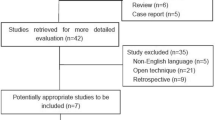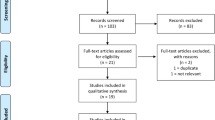Abstract
Purpose
In open inguinal hernia repair self-gripping meshes are currently commonly employed. Assumed benefits are saving of time, ease of handling and omission of fixation. Self-gripping meshes are, however, not as easy to handle and position as commonly stated. We describe a newly developed way of intra-operative mesh preparation and implantation and compare it to the conventional technique of insertion of self-gripping meshes.
Methods
A two-armed, randomized trial with 64 patients was performed. For implantation of the self-gripping, light weight and partially absorbable mesh we used either a newly described rolling technique (group 1: n = 32) or the conventional way of insertion (group 2: n = 32). Primary endpoints of the study were feasibility with regard to actual implantation time and surgeons’ satisfaction with the methods. Secondary endpoints were total operating time, length of hospital stay, postoperative pain, duration of pain medication intake and postoperative morbidity. In addition all patients were prospectively followed up according to the Hernia Med® registry’s standards.
Results
Implantation time (seconds) 140 ± 74 vs. 187 ± 84, p = 0.008, duration of pain medication intake (days) 3.6 ± 2.8 vs. 4.8 ± 2.6; p = 0.046 and postoperative morbidity 2 (6%) vs. 8 (25%) was significantly beneficial in group 1 (rolling technique) compared to group 2 (conventional method). Blinded questionnaire revealed that rolling the mesh is generally easier with less repositioning maneuvers than conventional placement. Neither overall procedure time, length of stay nor postoperative pain scores differed significantly between groups.
Conclusion
The newly introduced rolling technique for the actual placement of self-gripping meshes in open inguinal hernia repair is technically less demanding and therefore significantly faster when compared to the conventional way of insertion of the same product. In addition the rolling technique has shown to be safe for the patients and to also provide higher surgeons’ satisfaction.










Similar content being viewed by others
References
Kingsnorth A, LeBlanc K (2003) Hernias: inguinal and incisional. Lancet 362:1561–1571
Simons MP et al (2009) European Hernia Society guidelines on the treatment of inguinal hernia in adult patients. Hernia 13:343–403
Stechemesser B, Jacob DA, Schug-Paß D, Köckerling F (2012) Herniamed: an internet-based registry for outcome research in hernia surgery. Hernia 16:269–276
Chatzimavroudis G et al (2014) Lichtenstein technique for inguinal hernia repair using polypropylene mesh fixed with sutures vs. self-fixating polypropylene mesh: a prospective comparative study. Hernia 18:193–198
Ethical standard
The procedure described resembles a variation of a common, standardized procedure and does not violate current legislation to the best of all author’s knowledge.
Conflict of interest
All authors declare no conflicts of interest.
Author information
Authors and Affiliations
Corresponding author
Rights and permissions
About this article
Cite this article
Lechner, M.N., Jäger, T., Buchner, S. et al. Rail or roll: a new, convenient and safe way to position self-gripping meshes in open inguinal hernia repair. Hernia 20, 417–422 (2016). https://doi.org/10.1007/s10029-015-1389-y
Received:
Accepted:
Published:
Issue Date:
DOI: https://doi.org/10.1007/s10029-015-1389-y




